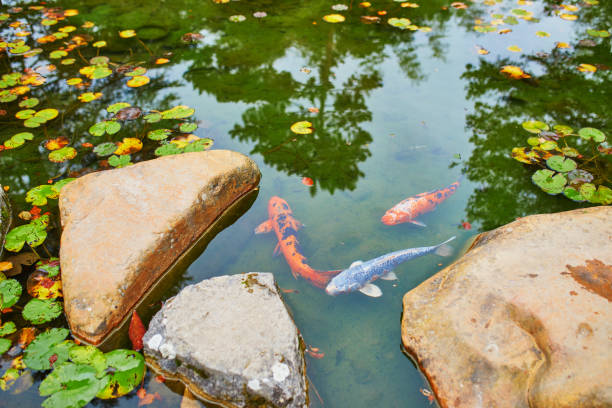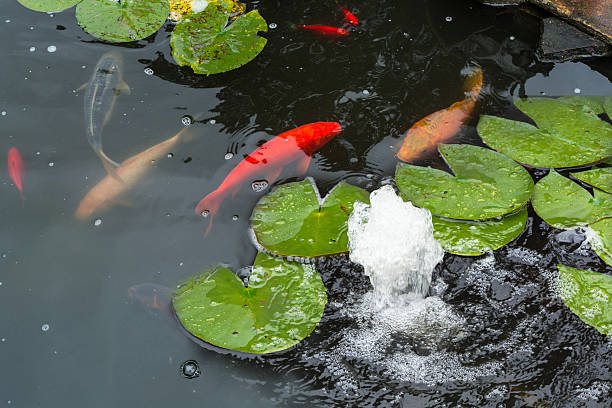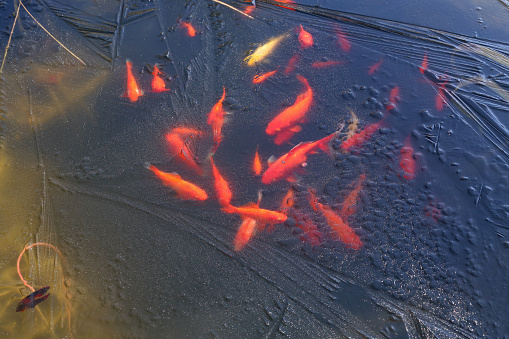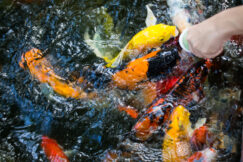Are you a koi pond owner looking for the best temperature to keep your fish happy and healthy? Look no further!
We’ve got all the information you need on what temperature should your koi pond be. Keep reading to find out more about ideal temperatures for your pond and how to ensure it stays at the right level.
Understanding the Optimal Temperature for Koi Ponds
Koi fish are cold-water fish, which means they thrive in water temperatures between 59-77 degrees Fahrenheit.
Because their metabolism is affected by the temperature of their habitat, it is important to ensure your pond has both shallow and deep areas so it does not freeze to the bottom.
It is generally accepted that the optimal temperature for koi ponds is between 15°C and 25°C (59°F and 77°F). During this temperature range, your koi will be their most active, feeding and growing more than in any other range.
If the pond’s temperature drops below 40°F (4.5°C), your koi will become less active due to the cold weather.
It is also important to note that water temperatures above 86°F (30°C) can be dangerous for koi, so it is important to monitor and regulate the temperature of your pond actively.
Monitoring the Temperature of a Koi Pond
Monitoring the temperature of a koi pond is essential for your fish’s health and well-being. To ensure a healthy environment and optimal conditions for your koi, you should keep an eye on your water temperature.
You can use a digital thermometer to measure the water temperature or install a pond heater to maintain a consistent temperature.
Additionally, you can use shade cloths or floating plants to help regulate the water temperature. By monitoring the temperature of your koi pond, you can create a healthy and comfortable environment for your fish.
The Benefits of Keeping a Stable Pond Temperature

Maintaining a stable temperature in your koi pond is essential for the health of your fish. A consistent temperature will provide your fish with a consistent environment, allowing them to live and thrive.
A stable water temperature can also help to prevent drastic changes that can cause shock or stress to your fish. Having a consistent temperature can also reduce the work needed to maintain your pond, as you won’t need to make frequent adjustments to the temperature.
Also, a stable water temperature makes it easier to determine if there is an imbalance in your pond, as sudden temperature changes can indicate that something is off balance.
Keeping a stable temperature in your koi pond is essential for the health of your fish and will make it easier to identify any problems early on.
Maintaining Ideal Temperatures During Colder Months
Maintaining ideal temperatures for your koi pond during colder months is an important part of keeping them healthy.
During the winter, the water temperature in your pond will naturally drop, so it’s important to take precautions to ensure your fish don’t get too cold.
One way to do this is by investing in a pond heater. A pond heater will help keep the water temperature constant, ensuring that your fish don’t get too cold.
You can also use an aerator or bubbler to help keep the water temperature constant. These devices circulate the water, bringing warmer water from the bottom of the pond to the top and vice versa.
This helps keep the pond’s temperature even more and prevents drastic temperature drops. If you don’t have an aerator or bubbler, you can add a water fountain or waterfall to your pond; these will also help keep the water moving and provide oxygen for your fish.
In addition to using a pond heater, aerator, or bubbler, it’s important to ensure that your pond doesn’t freeze over during
colder months. This can be done by keeping some areas of your pond shallow so that it doesn’t freeze all the way through or adding a de-icer. De-icers are electric devices that sit on top of the water and keep it from freezing.
It’s also important to check your koi fish regularly during colder months. They can suffer from ‘winter kill’ if the water is too cold.
How to Keep Water Cool During Hot Summer Months
Keeping your koi pond cool during the hot summer months is essential for the health and well-being of your fish. High temperatures can lead to stress, disease, and even death. To help keep your pond cool during the summer, you can take a few simple steps.
The first step is to ensure your pond has adequate shade. Trees, shrubs, and other vegetation can provide much-needed shade to your pond. Floating plants like lilies can also help to keep the water cooler by blocking out some of the sun’s rays.
Another way to keep your pond cool is by controlling algae growth. Algae blooms absorb heat and can quickly raise water temperatures to dangerous levels. Be sure to test your water often and use products designed to keep algae growth in check.
Finally, make sure your pond has an adequate supply of oxygenated water. Getting oxygen into the water is important not just for keeping it cool but also for keeping your fish healthy.
Ensure that your pump and filter are functioning properly and that your waterfall or fountain isn’t blocked or clogged. These simple steps can help ensure that your koi stay cool and comfortable all summer long.
Ensuring a Constant Water Flow in Your Koi Pond
Koi ponds need a constant water flow to ensure the health and well-being of the fish. Water movement helps oxygenate the pond, circulate food, and stabilize water temperatures.
If your pond does not have a consistent water flow, you should consider installing a pump or fountain to circulate the water. This will also help filter out any debris or waste from the pond, keeping it clean and healthy for your koi.
Also, having a consistent flow of water can help create currents that can encourage koi to be more active.
Using Aquatic Plants to Help Regulate Temperature

Aquatic plants are a great natural way to help regulate your koi pond temperature. Many aquatic plants can absorb excess carbon dioxide and other nutrients from the water and, in turn, reduce the temperature of the water.
Not only do they help to keep the water cooler, but they also provide extra oxygen and nutrients for the koi fish. Also, they provide shelter and hiding places for the koi fish, which can be beneficial when trying to reduce stress levels.
When selecting the perfect aquatic plants for your pond, be sure to choose those that are hardy and will thrive in your climate.
Safely Heating Your Koi Pond with a Submersible Heater
If your koi pond is in a colder climate, you may find it necessary to heat the water to keep your pond at the optimal temperature for your koi fish.
A submersible heater is an effective way to do this. Submersible heaters are designed to be placed directly into the pond and can be set to keep the water at a certain temperature.
When choosing a submersible heater, it is important to select one that is the correct size for your pond, as an overly large heater can cause the water to become too hot.
It is also important to check the heater regularly for signs of wear and tear, as faulty heaters can be dangerous and cause damage to your pond. When using a submersible heater, it is important to install a thermostat to monitor and control the temperature of the water.
Assessing the Risk Factors of Overheating your pond
Overheating your koi pond can be a serious problem as it can cause several negative health effects for your fish. In addition to increasing disease risk, it can lead to stunted growth and even death.
To ensure a safe environment for your fish, it is essential to assess the risk factors of overheating and take the necessary steps to prevent it.
The first step in assessing the risk of overheating is to understand the temperature range that is most suitable for koi fish.
As mentioned earlier, the ideal temperature range for keeping koi is between 59°F (13°C) and 77°F (25°C). When temperatures exceed this range, the risk of overheating increases significantly.
It is important to note that water temperature can rise quickly during the hot summer months. To ensure that your pond does not become too warm, it is essential to monitor the water temperature regularly and take steps to cool it down if necessary.
This can include using shade structures, adding aquatic plants, using a pond aerator, or installing a submersible heater.
Another important factor to consider when assessing the risk of overheating is the location of your pond. If your pond is exposed to direct sunlight, it will heat up more quickly than a pond in the shade. It is important to consider this pond to restock overheating.
Finally, it is essential to have a reliable source of water for your pond to keep it from overheating. If your pond does not have a reliable water source, it is more likely to overheat and dry out.
A good way to ensure that your pond has a reliable water source is to install a water pump. This will help to circulate the water and keep it from overheating.
Using Shade and Algae Control to Lower Temperature
Utilizing shade and controlling algae growth are important aspects of temperature control for a koi pond.
Shade can help keep the water temperature down in hot weather while controlling algae growth helps to prevent the water from becoming too warm due to algal blooms.
Adding shade to your koi ponds, such as trees or shade cloth, can reduce the direct sun exposure to the water, thus bringing the temperature down. Controlling algae growth through appropriate treatments can help keep the water temperature down in warmer months.
Algae blooms can cause water temperatures to rise and, if not addressed, can lead to dangerous conditions for your koi fish. Utilizing shade and algae control effectively keeps the temperature of your koi pond in check.
Considerations for Moving Koi Fish to Another Location
When considering the relocation of your koi, it’s important to remember that koi can be sensitive to changes in temperature.
Therefore, it’s important to ensure that the temperature of the new water source is within the ideal range of 59-77 degrees Fahrenheit. You should also consider the water quality of the new location and make sure that it is suitable for your koi.
Be aware of any predators or parasites that may be present in the new environment that could pose a threat to your koi.
It’s also important to note that koi are susceptible to stress when being moved, so try to do so in a way that minimizes their stress as much as possible. To ensure a successful move, it may be best to have a professional handle the relocation process.
Setting Up an Emergency Plan In Case of a Power Outage
No matter how careful you are with maintaining the ideal temperature for your koi pond, there’s always the risk of a power outage. While this is a rare occurrence, it’s important to have an emergency plan in case of such an event.
If there’s no power to your pump and filter, the oxygen levels in the pond can drop quickly, causing your koi fish to become stressed and potentially die. To prevent this, stock up on a few backup supplies, such as an extra battery-operated filter, air pumps, and aerators.
Additionally, you should have multiple buckets or containers filled with pond water that can be used to fill up the pond in case of an emergency.
Finally, you should purchase an emergency generator or invest in a solar-powered water pump that can be used during a power outage. Having these items on hand ensures that your koi fish will remain safe during any unexpected events.
Conclusion
Koi ponds must be maintained at the right temperature to ensure the fish thrive. The optimal temperature range for these ponds is between 59°F (13°C) and 77°F (25°C).
To maintain this temperature level, it is important to monitor the water temperature, create shade and algae control, consider using a submersible heater, and have an emergency plan in case of a power outage.
It is also important to ensure a constant water flow in the pond and use aquatic plants to help regulate the temperature. Following these steps, koi owners can create a healthy environment for their beloved fish.




